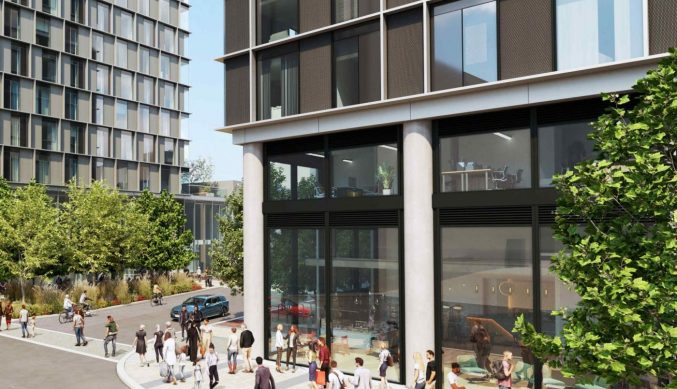Semi-commercial goes full steam ahead
By David Craik

The Covid Pandemic has accelerated the economic and social shift from physical to digital commerce.
A series of lockdowns have kept consumers away from our high streets and hospitality businesses such as pubs and cafes.
For some major firms such as retailer Debenhams the impact was enough to close their doors, but others staved off disaster by ramping up their digital and e-commerce operations.
Pubs and cafes organised new delivery services and retailers enhanced online and mobile commerce options for customers.
This shift, driven by continued economic uncertainty and Covid fears, is likely to remain in the months ahead. Physical retail and hospitality will survive but there will likely be less need for stores, shops and pubs in our high street and out of town retail parks.
Indeed, according to estate agents Keller Williams, the closures will leave nearly 20million square feet of unused retail space in the UK.
That space will need to be filled somehow and it seems semi-commercial options will increasingly be in vogue as a solution. That means opportunities for specialist and bridging lenders.
“Semi-commercial is certainly a bigger part of our business now,” says Steve Smith, key account manager at Roma Finance. “Twelve months ago, it would have been around 10% and now it is up to 23%.
It’s not news to anybody that the High Street was in trouble before the pandemic. But since then, Covid has changed the way we shop with pubs and hospitality also being affected. As a result, we are seeing more semi-commercial demand and commercial going semi as well.”
He says vacant banks and pubs are being renovated and turned into fully residential or part commercial/residential.
“There is a decreased need for retail and commercial premises and pubs, so the increasingly popular option is to convert rooms into residential on top floors, refurbish them and let them out,” he says.
“We’re seeing a huge influx of semi-commercial in larger cities such as Leicester and Stoke but also small villages and towns. Landlords know they can make money from residential.”
Paresh Raja, chief executive of lender Market Financial Solutions, is also seeing growing demand.
“Clients are considering ways of diversifying their property portfolios leading to increased interest in the semi-commercial sector,” Raja says.
“There are a number of potential reasons for this. For one, UK high streets have been hit hard by the pandemic and business closures have left many commercial and semi-commercial premises empty.
The same can be said of office buildings, many of which have been abandoned as organisations transition to remote working for the foreseeable future.
With opportunities aplenty, some investors are clearly moving into this space, potentially with a view to refurbishing and changing the usage of a venue, whether that’s from retail to hospitality or vice versa.
Indeed, as lockdown rules are lifted and society sparks back into life, we could see more investors looking to the semi-commercial sector.”
He adds that the ‘various rules and reforms’ that have been implemented in the buy-to-let space over recent years have been another key driver.
“As we know, residential landlords now generally face stricter regulation and higher taxes, which might also be inspiring some investors to consider other real estate markets such as semi-commercial, which provide opportunities for higher yields, or development potential,” he states.
The scale and value of semi-commercial properties is also increasing, Smith adds. Semi-commercial loans now average £300,000 compared with a previous average of around £200,000.
“Where previously you would have one flat on top of a bookmakers or grocers, we are now seeing two or three flats.
In fact, we are increasingly being asked whether we have a minimum size of flat that we lend on,” Smith says. “There is also more effort to make the flat look nicer, more appealing and in keeping with the area.
They used to be forgotten flats on top of supermarkets. Now, younger people want to live in towns and cities and are happy to rent places above commercial sites.”
Roma changed LTVs on semi-commercial last year to 65% from 60%. “We did that with commercial as well as we are seeing a lot of crossover between the two at the moment,” he says.
“A lot of landlords own both, so it makes it easier to have the same LTVs. We are looking more at the borrower and their skillset. This isn’t the time to start living your dream of owning a pub! We are more comfortable if you have 20 years of experience behind you.”
Aside from pubs, banks and retail, InterBay Commercial is seeing greater demand for semi-commercial holiday lets which fit in with the current trend of UK staycations.
“Landlords are looking to semi-commercial as the next step-up,” says Emily Machin, Head of Specialist Finance. “There could be opportunities for existing tenants to purchase the entire freehold and gain income from the rent on the uppers, or for businesses to take on premises with the added security of letting out the residential element.
We don’t insist on a percentage of the asset to be for used for residential use so there could also be opportunities to create more office space as well as residential flats.”
Despite this rise in demand, Kim McGinley, director of VIBE Finance, says many more lenders could be offering semi-commercial products.
“Those that are lending in this space tend to play it safe and cap their loan to values accordingly.
We’re finding that many lenders will approach these types of cases on an individual basis, and it can come down to so many factors – client experience, tenants, demand, LTV and the loan being sought,” she says.
“It’s working with those lenders that can take a common sense approach to this type of borrowing. More importantly, on these types of cases it’s imperative to have the exit from the bridging loan lined up as investment lenders can be few and far between on a term loan product.”
Indeed, Smith says that funders offering fully commercial exits have ‘gone’.
“We need to keep an eye on the market to ensure that there are exits for the refinance after the bridge,” says Smith. “At the moment, funders are happy with semi-commercial exits.
Fully commercial exits are a little bit more difficult. A lot of funders have pulled back from giving exits to hospitality and some retail on the high street.”
Marcus Dussard, sales director, Specialist Mortgages Division at Hampshire Trust Bank, says it remains strong in the semi-commercial space but has also made criteria adjustments in the pandemic.
“Where we would have been wholly reliant pre-pandemic on the commercial income being part of the loan and exit proposition for semi-commercial, we had to make changes given economic uncertainty and lockdown,” he explains.
“Now we look at how reliant on the residential rent the landlord is to service the interest. We also took the decision, in some circumstances where the commercial elements of a semi-commercial development were no longer open, to pull back on LTVs.
Even covenants with large grocery retailers are looking less secure as business models change, and more businesses cut their estates. That adds to the level of questioning we have over how much commercial income to consider for a particular case.”
He adds: “Semi-commercial can lose money pretty quickly during void periods. It isn’t like pure residential that you turn around quickly. So, with commercials you are increasingly looking at that potential vacant lot value from the start.”
However, overall, lenders see further growth in semi-commercial ahead.
“As social distancing rules are relaxed and the stamp duty holiday tapers down, I believe the semi-commercial market will be one to watch within the property investment sector,” says Raja.
Smith adds that uncertain times remain for retail and hospitality businesses especially when Government support schemes end.
“It will be a very strong market for semi-commercial in the next 12 months,” he says. “Landlords and borrowers are thinking we can put an apartment in, get people paying rent and that will subsidise if we have a lowering of commercial rent.
People are just using the residential side more cleverly than they did before.”

David Craik is a freelance journalist writing news, feature articles, blogs and guides for national newspapers and magazines. His main areas of interest include finance, property and investments.










You must be logged in to post a comment.